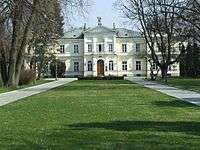Warsaw University of Life Sciences
| Szkoła Główna Gospodarstwa Wiejskiego | |
 | |
| Established | September 23, 1816 |
|---|---|
| Rector | prof. dr hab. Alojzy Szymański |
| Location | Warsaw, Poland |
| Affiliations | Leonardo Da Vinci, SOCRATES, BUDDY, CEEPUS, ARENA, PHARE-SCI-TECH, PHARE-ACE, SENECA, COST, JEAN MONET, FAIR, TEMPUS |
| Website | www.sggw.pl |
The Warsaw University of Life Sciences (Polish: Szkoła Główna Gospodarstwa Wiejskiego, SGGW, literally "main school of rural economy") is the largest agricultural university in Poland. It was founded in 1816.
History
On 23 September 1816 the School of Agronomy was founded at Marymont and was accommodated in the palace of Marie Casimire Louise de La Grange d'Arquien. Branches were established at Bielany, Ruda, Wawrzyszew and Buraków. An Institute of Veterinary Medicine was established at Rządowa, followed by the Institute of Rural Economy and Forestry in 1840. As Poland was ruled by the Tsar of Russia there were attempts at Russification which nearly resulted in the closure of the school, but it was transferred first to Puławy and later to Russia. After the independence of Poland in 1918 the Institute was returned to Warsaw and became the Major School of Rural Economy in 1919. Horticultural studies were added to those of agriculture and forestry in 1921. Activity was disrupted by the Second World War and resumed in 1945. The veterinary faculty was transferred from the University of Warsaw in 1952, and later the departments of agricultural drainage, wood technology, animal husbandry, and of landscape, now known as the Landscape Architecture Section, were established. Land and farms at Wolica and Natolin were acquired in 1956 and used for development. In 1973 the faculties of agricultural technology and human nutrition were established. The Rector of the university has an office in the historic palace of Julian Ursyn Niemcewicz, now known as "the rector's palace."
Subjects of study
- Landscape architecture
- Food safety
- Bioengineering of animals
- Biology
- Biotechnology
- Architecture
- Dietetics
- Economics
- Finance and banking
- Planning
- Breeding and protection of domesticated and wild animals
- Informatics and econometrics
- Environmental engineering
- Silviculture
- Environmental protection
- Horticulture
- Agriculture
- Sociology
- Agricultural and forestry practice
- Wood technology
- Sciences of raw materials
- Tourism and leisure
- Food technology
- Human nutrition
- Veterinary medicine
- Production management and production engineering
- Management and marketing
- Zootechnics
- Logistics
Faculties and interfaculty studies
- Faculty of Civil and Environmental Engineering
- Faculty of Production Engineering
- Faculty of Forestry
- Faculty of Veterinary Medicine
- Faculty of Economic Sciences
- Faculty of Humanities
- Faculty of Animal Sciences
- Faculty of Human Nutrition and Consumer Sciences
- Faculty of Food Sciences
- Faculty of Horticulture and Landscape Architecture
- Faculty of Agriculture and Biology
- Faculty of Wood Technology
- Faculty of Applied Informatics and Mathematics
- Interfaculty Studies in Biotechnology; Regional Planning; Environmental Protection; Commodity Science; Tourism and Leisure
See also
Coordinates: 52°9′42″N 21°2′53″E / 52.16167°N 21.04806°E
|